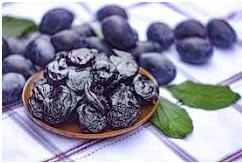Most prunes are freestone cultivars (the pit is easy to remove), whereas most plums grown for fresh consumption are clingstone (the pit is more difficult to remove).
Prunes are 64% carbohydrates, including dietary fiber, 2% protein, a rich source of vitamin K, and a moderate source of B vitamins and dietary minerals. The sorbitol content of dietary fiber likely provides the laxative effect associated with consuming prunes.
Q. What are prunes called in India?
ANS. Alu Bukhara.
Prunes are actually the dried version of European plums and are also known as dried plum. In India, the prune (both dried and fresh) is known as Alu Bukhara in Hindi.
Q. What are prunes good
for?
ANS. Here are 11 top health benefits of
prunes and prune juice.
· Helps
digestion. Prunes are high in fiber, which helps prevent constipation. ...
· May
help control the urge. ...
· High
in potassium. ...
· High
in vitamins. ...
· Provides
a good source of iron. ...
· Builds
bones. ...
· Reduces
cholesterol levels. ...
· May
help lower blood pressure.
Q. Is prune and raisins
the same?
ANS. The main difference between prunes and
raisins is that prunes are a species of dried plums, while raisins are
dried grapes.
Q. Which fruit is prune?
ANS. Plums
Prunes are plums that have been dehydrated for
preservation purposes. Sometimes called dried plums, prunes are deep
red-brown with a chewy texture and a savory-sweet flavor.
Q. Can prunes be eaten
daily?
ANS. Feren says prune lovers are advised
to eat around 30 grams, or three to four prunes, a day. That is equal to
one serve of fruit – adults are encouraged to have two daily serves of fruit.
He adds that your second serve of fruit per day should be made up of other
fruit varieties.
Q. What is the Indian
substitute for prunes?
ANS. Though you may not get the same properties,
prunes can be substituted with dried figs or the Indian jardaloo (a
kind of apricot). The iron content is high in both and the taste is also
sweet, similar to prunes.
Q. Who should not eat
prunes?
Q. Are prunes called
dates?
ANS. Dates and prunes are usually consumed in
their dried form and look similar. However, they are two completely
different species of fruit, and each has its own specific properties:
Taste: Dates are the sweeter of the two fruits. Eaten raw, they are less
intensely sweet, and will have a lighter texture.
Q. Why do men eat prunes?
ANS. Prunes have vitamins and minerals that
likely work together to protect the bone, including fiber, vitamin
K, magnesium, potassium, boron, copper and polyphenols.
Q. How many dried prunes
should I eat a day?
ANS. Hooshmand says how many prunes you should
eat in a day depends on the size of the prunes themselves, but current research
recommends 50 grams of prunes per day which is equal to about 5 to 6
prunes.
Q. Which country is
famous for prunes?
ANS. California produces 99 percent of the
nation's prunes and 70 percent of the world's prune crop. Other major
prune-producing countries are France, Chile, and Argentina.
Q. Are prunes good for
weight loss?
ANS. Research by the University of Liverpool has
found that eating prunes as part of a weight control diet can improve weight loss.
Consumption of dried fruit is not readily recommended during weight loss
despite evidence it enhances feelings of fullness.
Q. What are the benefits
and side effects of prunes?
ANS. Some possible prunes benefits include better
heart, gastrointestinal, bone, and digestive health, a controlled appetite, and
a slower aging process. However, they also have some drawbacks, including
possible allergies, increased diarrhea risk, gastrointestinal distress, and
exposure to acrylamide.
Q. Are prunes a
superfood?
ANS. Dried prunes are great to snack on.
Also, it is one superfood that helps you maintain your
appetite, and controls the urge for sugary and fried food. That's all because
of pectin.
Q. Are prunes high in
sugar?
ANS. Photo Alto. "Dried fruit often gets a
bad rap for people with diabetes, but prunes contain no added sugars, are lower
on the glycemic index scale than most dried fruit, and provide three grams of
fiber per serving," says Palinski-Wade.
Q. What is the difference
prune and plum?
ANS. A plum is a relative of cherries, peaches,
and almonds while a prune is a variety or a type of plum. Most varieties of plums
have red skins when ripe, but prunes have blue or purple skins when ripe.
Prunes are oval-shaped while other types of plums are either heart-shaped or
round-shaped.
Q. Are prunes better than
raisins?
ANS. Prunes: They are lower in sugar and
calories than raisins, rich in fiber, and pose less risk from pesticides.
Goji berries: While high in calories, they contain about 30% less sugar than
raisins and higher levels of antioxidants.
Q. Is it better to eat
prunes at night?
ANS. Prunes which are basically dried plums are
excellent for sleep. They are rich in vitamin B6, calcium, and magnesium and
help in the production of melatonin, the hormone that regulates sleep.
Q. Do prunes help you
sleep?
ANS. Prunes. The nutrients in dried plums —
vitamin B6, calcium, and magnesium, to name a few — help make
melatonin, the hormone that regulates sleep. Use prunes as a whole-grain
toast topping, mix them into trail mix, or eat them on their own about 30
minutes before bedtime.
Q. What is the healthiest
way to eat prunes?
ANS. Adding more prunes to your diet
· Eat
them alone as a snack.
· Add
prunes to your breakfast oatmeal.
· Mix
them with nuts, other dried fruits such as apricots, and dark chocolate chips
for a healthy trail mix.
· Add
them to baked goods.
· Blend
them (or use prune juice) for drinks or smoothies.




0 Comments